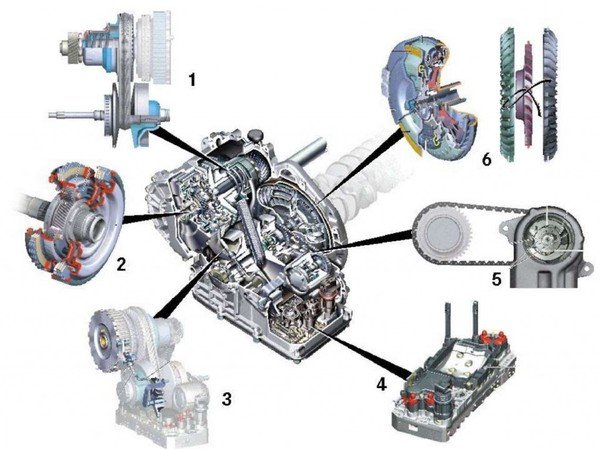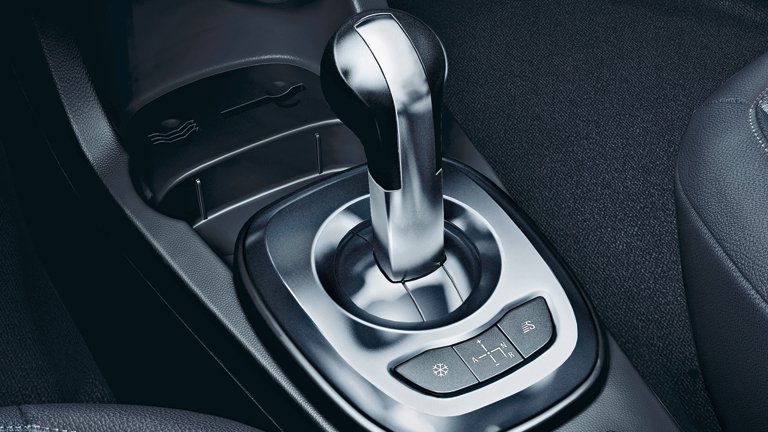Easytronic transmission. Design peculiarities. Pros and cons. Typical problems and Tips on Easytronic.
Joint efforts of Opel and Luk engineers led to development of the automated Easytronic gearbox which combines advantages of manual and automatic transmissions. In this article, we will consider design peculiarities, operating modes, pros and cons, typical problems of the Easytronic transmission and tips on how to prolong its service life.

Easytronic is the tradename introduced by the German carmaker Opel. Today, this type of gearbox is used in the following Opel models: Corsa, Vectra, Astra, and Zafira.
This automated transmission has shafts and
gears like a manual gearbox, but at the same time the process of gear shifting
is implemented with the help of the Easytronic control unit.
The Easytronic clutch is not actuated by
pressing the pedal, like in manual transmissions (there is no clutch pedal in
cars with the Easytronic transmission at all), but is triggered automatically
by means of the control unit and the electro-hydraulic drive gear. The
Easytronic transmission is based on a standard 5-speed manual transmission
supplemented by the clutch linkage and the gear actuation drive.
The Easytronic
transmission consists of the following components:

- Self-adjusting clutch (SAC). This element automatically adjusts the degree of wear and ensures constant and not very high pressure, thereby increasing its service life;
- Clutch drive (consists of electric motor, worm reduction unit, and cam mechanism interacting with the piston driver of the clutch master cylinder);
- Electronic control unit (ECU). This unit is responsible for the following functions: reception of input signals from sensors, selector lever, etc., determination of the gear to be engaged, check of the signals and calculation of output parameters, and transmission of signals to actuators. During operation, the control unit interacts with the engine management system and the anti-lock braking system (ABS);
- Manual gearbox;
- Mechanism responsible for selection and engagement of gears (consists of two gearboxes driven by two electric motors). This mechanism is responsible for movements of the gear selector, which, in turn, selects and engages the required gear;
- Gear selector (one of the ECU elements). A separate sensor determines the position of the selector and generates a signal for transmission to ECU.
Modes of operation
The Easytronic gearbox has two main modes of
operation: automatic and semi-automatic. Let’s consider these modes in more
detail.
Automatic mode (the gearbox is fully controlled by the ECU system). In this mode, the Easytronic gearbox is similar to a conventional automatic transmission, because the gear shifting is performed automatically. But, there is one difference! Since Easytronic is an automated gearbox, there is interruption in torque delivery during the process of gear shifting. Thus, it is necessary to release the accelerator at the moment of gear shifting.

Due to control signals from the ECU system ,
the following sequence of events takes place:
- Torque is reduced;
- The clutch is disengaged;
- The gear is selected;
- Shafts rotation is synchronized;
- The gear is actuated;
- The clutch is actuated;
- Torque is increased.
When it comes to the semi-automatic mode of
operation (also known as “Active Select”), the driver must shift gears
manually. The driver shifts gears sequentially with the help of the selector
lever. In fact, this mode of operation is similar to the Tiptronic mode
implemented in automatic transmissions.

The Easytronic transmission also has other operation modes such as: sports mode, economy mode, and winter mode. In winter mode, the car starts from the 2-nd gear on slippery surfaces. The sports mode is notable for more abrupt engagement of gears (the car starts active acceleration). The kick-down mode (shifting to a lower gear) is also worth mentioning. Thanks to this mode, the driver can ensure faster acceleration for overtaking by sharply pressing the gas pedal.
Pros and cons of Easytronic
The Easytronic transmission, as any other
transmission, has its pros and cons. So, let’s consider the main advantages and
disadvantages of this transmission.
Pros:
- Lower price in comparison with automatic transmissions;
- Good acceleration dynamics;
- Fuel efficiency.
Cons:
- Delay during gear shifting;
- Jerks when shifting gear;
- Short service life of the transmission;
- Expensive maintenance and repair.
Why Easytronic is used only in Opel cars
Currently, Opel/Vauxhall actively uses
Easytronic transmissions in its models – Zafira, Astra, Corsa. Most other car
manufacturers prefer classic automatic transmissions or CVTs. There are several
reasons for this. First of all, many carmakers are troubled by interruptions in
torque delivery. Secondly, due to design peculiarities, the Easytronic
transmission requires frequent maintenance. As a result, over time you have to
change the clutch. Thus, the Easytronic transmission doesn’t have significant
advantages over other types of transmission.
Typical problems of Easytronic
If electronic sensors detect a malfunction, the
driver will see the alarm icon F. Such malfunctions should be addressed
immediately. The list of possible failures in the automated transmission
Easytronic includes the following:

“F” icon indicating the transmission problem
- ECU failure;
- Malfunction of the clutch master cylinder (the regulator valve becomes dirty, thus the master cylinder cannot keep the pressure and the car moves with jerks);
- Wear of the output shaft in the mechanical part of the transmissions (specific roaring sound appears when driving);
- Loss of contacts in the electrical part, burn-out of the selector protector;
- Clutch plate damage (parts of the damaged clutch plate clog the system).
Great video on Easytronic repair
Rules and recommendations on operation of cars equipped with the Easytronic gearbox
Many drivers, having bought the Opel car with
the Easytronic gearbox, expect it to work as an automatic and eventually become
very disappointed. It is necessary to get used to this transmission and follow
several simple rules.
- The period of the first 2-3 thousand kilometers is known as a break-in period, therefore during this period it is necessary to forget about aggressive driving.
- Opel specialists say that it is absolutely unacceptable to leave the car parked with the engaged gear. When you park the car it is necessary to shift to the N-gear with the handbrake on.
- When you stop at traffic lights or in traffic jams, it is better to shift to the N gear.
- It is necessary to release the gas pedal when shifting gears (otherwise the RPM speed will be reduced, and, as a result, some jerks may occur).
- It is extremely important to monitor the condition of brake lights and electrical circuits while driving the car equipped with the Easytronic transmission, since the control module of the transmission will not understand whether the brake pedal is pressed or not, because of the open circuit (as a result of the burned-out bulb)
Disregard
of these rules on the Easytronic transmission operation may lead to failures
described above. In general, you can drive smoothly and comfortably in an Opel
car with Easytronic, if you learn the peculiarities of this transmission and
follow some simple rules. Opel's Easytronic is advertised as a low-cost
alternative to a traditional automatic gearbox for city drivers.









